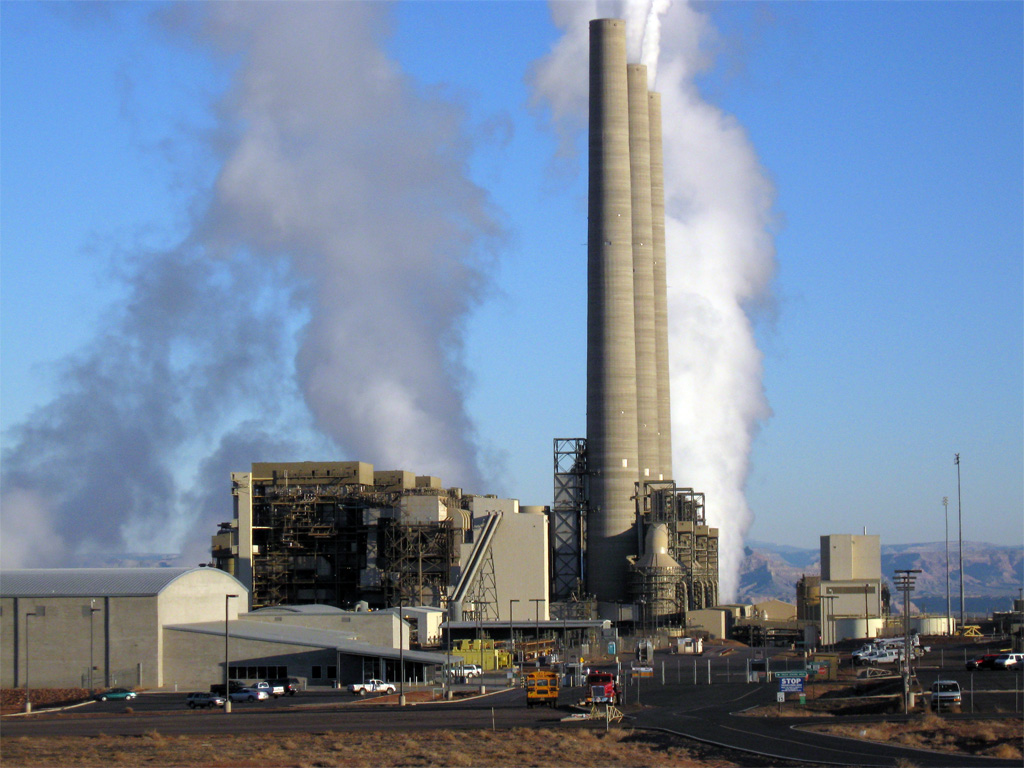In September 2018, two prospective buyers announced they were dropping out of negotiations to purchase the Navajo Generating Station (NGS), the American West’s largest coal-fired power plant.
Avenue Capital Group and Middle River Power had sought to keep the aging coal plant in business, but “said they could not get anyone to commit to buying power from the plant, delaying the start of an environmental review,” the Associated Press reported. The plant, located in northern Arizona near the Utah border, is currently scheduled to shut down in December, after its current owners concluded in 2017 that its power was too costly to be competitive.
The two firms had progressed further in talks with the coal power plant’s owners than any of the 15 others identified as potential buyers by a consulting firm hired by Peabody Energy, which for decades has mined the coal burned at the plant.
A think tank that’s been backed by Peabody Energy is pushing the sale of the ailing plant and coal mine — and is now finding an audience in the Navajo Nation with the help of a Heartland Institute policy advisor.
Supporters of the deal argue it could forestall layoffs for another five to 10 years in a region where jobs are scarce. Even during decades of mining for coal and uranium and drilling for oil and gas, unemployment in the region has hovered around 50 percent.
Local opponents warn that if the Navajo Nation buys the mine, it will also buy the cleanup costs. They’ve proposed creating jobs by building a renewable energy power system in the area instead, using the coal plant’s existing transmission lines to transport that electricity to places like Los Angeles and Pheonix.
“The Navajo Generating Station and the coal mines on Black Mesa were built on a foundation of theft and colonialism. But closing them down will not help unless it is done in a just way, one that heals old wounds rather than opening new ones.” https://t.co/KbQjyUJmWa
— Sammy Roth (@Sammy_Roth) February 19, 2019
Coal and Water
Peabody, which emerged from bankruptcy in 2017, owns the Kayenta coal mine on Navajo Nation land. Kayenta mine’s only customer is the Navajo Generating Station and its three 750-megawatt generators. Since the 1960s, Peabody has mined coal from Kayenta and other mines on Black Mesa, a mountainous region of Hopi and Navajo land in the northeastern corner of Arizona.
It’s the coal seams that make Black Mesa black — and it’s the coal mines that locals say dried up the groundwater that thousands of people living in the region rely on. Over 8,000 homes on Navajo lands here lack access to drinking water, according to Stanford’s Water in the West.
The Kayenta Mine, a surface coal mine in the Navajo Nation in Arizona. Credit: Doc Searls, CC BY 2.0
The Kayenta coal mine, a 44,000-acre strip mine connected to the Navajo Generating Station by rail, uses 1.3 billion gallons of water a year. Locals report that the coal mine has drained the arid region’s underground water supply, drying up the springs, seeps and water wells fed by the N-aquifer under Black Mesa that have historically made this corner of Arizona habitable.
“We don’t have any water, I don’t have any water — simply because it’s been dedicated all to the Peabody mine,” said Percy Deal, a retiree and former Navajo Council supervisor who has lived his entire life on Black Mesa just south of the Kayenta mine, on land where his family has lived for generations.
Locals must now drive significant distances to community springs to fill up 50-gallon drums of water to use in their homes, for their livestock, and occasionally for agricultural use.
“I haul water just like thousands of people, we have to haul water,” Deal said, estimating that he had to make the drive, roughly 20 miles each way, about every other week.
When the coal mine and power plant shut down for good, decommissioning and cleanup are slated to begin — and already there are signs that disputes over who will have to pay those costs are on the horizon.
 Nicole Horseherder, executive director of Tó Nizhóní Ání, testified before Congress about the Navajo Generating Station last year.
Nicole Horseherder, executive director of Tó Nizhóní Ání, testified before Congress about the Navajo Generating Station last year.
On February 13 a legal notice was sent to Peabody Western Coal Co. by Tó Nizhóní Ání (a Navajo community organization advocating for water on Black Mesa), Black Mesa Water Coalition, and the Sierra Club, asserting that a Peabody estimate for “final reclamation costs” shows $187.9 million in expected expenses. The notice alleges that in April 2017, Peabody sent a notice to Navajo Generating Station’s owners informing them that Peabody holds them liable for 71.4 percent of the mine’s reclamation costs.
The February 13 notice claims Peabody broke the law by failing to tell federal mining regulators that the mine was closing and that it sought to shift cleanup liability onto the shoulders of others during a subsequent permit renewal.
“Peabody is trying to sidestep its reclamation responsibilities by pretending the Navajo Generating Station isn’t on track to close in 2019, but it is, and that’s been the case for two years,” Jihan Gearon, executive director of Black Mesa Water Coalition, said in a statement.
Buyers Back Out
As coal has struggled to compete against cheaper power from other sources (including natural gas, a fossil fuel whose prices have plunged amid the shale gas rush), coal power plants across the U.S. have been shuttered. Over 260 coal plants have closed since 2010, and the carbon-intensive fossil fuel’s share of the country’s power market has plunged from more than half to less than a third in the past 15 years.
Competition from other fuels — not only from natural gas, which brings climate change concerns potentially even more severe than coal, but also from renewable energy — has become fierce.
“Coal is the most expensive fuel for electricity generation on the market, with electricity from the [Four Corners Generating Station, another coal plant on Navajo land] costing around $79 per MWH [megawatt-hour] as compared to $18 per MWH for wind power (with storage) and $35 per MWH for utility scale solar power with storage,” Tom Ribe, executive director of Caldera Action, wrote in a January 22 column published by The New Mexico Political Report. “Natural gas power plants generate power at around $63 per MWH.”
In fact, the Central Arizona Project, a local water utility, struck a deal to replace some of the power from the Navajo Generating Station with solar generation, an agreement that would provide electricity at half the cost of power from the coal plant, GreenTechMedia reported in June.
It’s in this environment that in September, Avenue Capital and Middle River Power walked away from a deal that the coal plant’s supporters had hoped might extend its life (DeSmog previously covered protests in New York against that deal). A spokesperson for the buyers explained to the Navajo Times that they had been unable to secure commitments from customers to buy enough power “to enable a workable operating paradigm.”
Yesterday sort of summed up life on the coal beat.
First, did a story on power companies swapping coal for renewables in the Heartland https://t.co/fUDsAtEzXt
Then got news the only buyer for Navajo Generating Station was pulling its bid https://t.co/jLn10A3yos
— Ben Storrow (@bstorrow) September 21, 2018
Making the Transition
Another potential buyer may now be waiting in the wings. In January, the Navajo Times reported that the Navajo Transitional Energy Company (NTEC) had approved a measure to continue negotiations to buy up the plant and mine on behalf of the Navajo Nation. NTEC, which describes itself as “a wholly owned limited liability company of the Navajo Nation,” previously purchased the Navajo Mine supplying coal to the Four Corners Power Plant.
Nearly 500 people — 90 percent of whom are Navajo — work full time at the Navajo Generating Station, and hundreds more work in the Kayenta coal mine. The Hopi and Navajo tribal governments also bring in roughly $50 million a year in revenues from the plant.
“Closing the [Navajo Generating Station] in 2019 would have a devastating impact on our nation by immediately eliminating thousands of jobs and dramatically reducing our revenue,” Russell Begaye, then-president of the Navajo Nation, wrote in a 2017 The Hill op-ed calling on the Trump administration to fulfill Trump’s pledge to “bring back coal.”
The Navajo Generating Station. Credit: Doc Searls, CC BY 2.0
With those efforts failing, NTEC is looking into acquiring the power station and the Kayenta mine. “We believe there is a clear and beneficial path forward to acquire and operate both [the Navajo Generating Station] and Kayenta Mine as a vertically-integrated entity,” NTEC CEO Clark Moseley said in a statement reported later that month.
Other Navajo Nation members are critical of the deal, arguing that a purchase would be financially risky for the Navajo Nation since other prospective buyers concluded the plant couldn’t be profitably run.
They add that even if the plant does close, some jobs will remain — and some new ones will open up.
Roughly a third of the coal plant’s employees signed on to work at another regional power plant, others would remain to decommission the plant and start cleanup, and still more can get jobs building new solar facilities that would use the Navajo Generating Station’s transmission lines.
“They’re scaring the people saying that all of the jobs will be lost,” said Deal. “There’s going to be a period of five to six years for decommissioning, cleanup, and restoration — and there’s going to be jobs there.”
“When they said there’s going to be 700 jobs lost,” he said, “that just simply isn’t true.”
Peabody-Linked Texas Public Policy Foundation Behind Video Touting Jobs
NTEC is run by three former coal company executives — all hailing from companies that have troubled histories, critics say. NTEC’s CEO previously led a coal export project in Oregon which was defeated following local opposition, its CFO was a vice president at Alpha Natural Resources, which filed for bankruptcy in 2015, and its COO left the now-bankrupt Westmoreland Coal for NTEC in 2016.
A new website, www.savenativeamericanfamilies.com, was first created in September 2018.
The Peabody-linked Texas Public Policy Foundation’s video about the Navajo Generating Station featured on the website Save Native American Families.
Gerges Scott, the only representative named on the Save Native American Families (SNAF) website, works for a Washington, D.C.-based public relations firm called Agenda Global. “At Agenda Global, Gerges Scott leads the energy unit that helps industry clients overcome challenges related to regulatory, government, media, and community support,” his firm bio says. “Gerges has represented an array of organizations — from industry coalitions to actively producing energy companies.”
An undated curriculum vitae for Scott also lists the “Navajo Nation,” which wholly owns NTEC, as one of his clients. Scott serves as a “Policy Advisor” for the fossil fuel-funded think tank the Heartland Institute, according to the institute’s “Who Are We” web page.
The SNAF site features a video praising the Navajo Generating Station that was published on YouTube in August 2018 by the Texas Public Policy Foundation, part of its Life:Powered project. “Extreme environmentalist policies will eliminate jobs, destroy families, and spike electric bills in the Navajo Nation and across America,” a slide at the end of the video says. It suggests jobs at the coal plant could continue another decade if it stayed open.
So why is a Texas-based organization making a video about the Navajo Generating Station?
It’s worth noting that while the Texas Public Policy Foundation‘s mission is explicitly centered on Texas (and Texas does not buy power from the Navajo Generating Station), the foundation does have direct financial ties to Peabody Energy, which owns the Kayenta mine.
The Texas Public Policy Foundation is listed as a creditor in Peabody’s Chapter 11 bankruptcy documents from 2016 published by the watchdog group Center for Media and Democracy.
“Although the documents filed so far do not show the scale or precise dates of funding — they only list current creditors — they demonstrate for the first time that Peabody Energy has financial ties to a very large proportion of the network of groups promoting disinformation around climate change,” the center reported at the time, specifically noting that the Texas Public Policy Foundation had “direct financial ties to Peabody.”
Peabody told investors that it was planning for an October shutdown of the mine, E&E reported earlier this month, but a company spokesperson added that Peabody “continues to support” a transition that would keep the Navajo Generating Station and the Kayenta mine open.
And Peabody, locals say, has a big incentive to support a deal.
“They have everything to gain if they can pass on their liability for this dying plant, the dying mine,” Nicole Horseherder, the executive director of the Navajo group Tó Nizhóní Ání, who also lives near the mine, told DeSmog.
Nicole Horseherder asks tough questions about Navajo Generating Station and the impacts of a buyout proposal from Middle River Power and continued harm to Navajo people. More questions than answers. pic.twitter.com/qQH2ArAAJA
— Sandy Bahr (@SLBahr) August 14, 2018
If the Navajo Nation were to buy the plant and mine, Peabody could shift liability for the shutdown onto the shoulders of the Nation. While supporters of a deal point towards an escrow fund they say has kept “tens of millions of dollars” established for cleanup costs, critics say that Peabody’s own numbers show costs could run far higher than that.
“There’s not going to be a proper reclamation program, there’s not going to be a proper cleanup program, that’s what we’re worried about,” Deal said.
Instead, both said they supported requiring Peabody to clean up after itself and creating new jobs by investing in solar power on Navajo lands.
“All of the pieces are there to actually put renewable energy on those transmission lines,” Horseherder told DeSmog. “We just need to come to terms that [the Navajo Generating Station] has got to close first.”
Main image: Navajo Generating Station 2, Located near Page, Arizona. the Navajo Generating Station is a coal-fired power plant consisting of three 750 MW units. Credit: Alan Stark, CC BY–SA 2.0Subscribe to our newsletter
Stay up to date with DeSmog news and alerts









